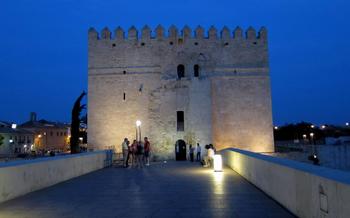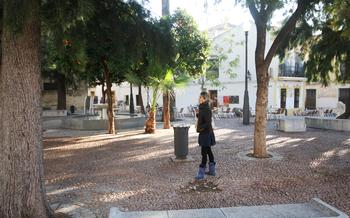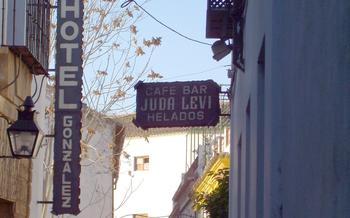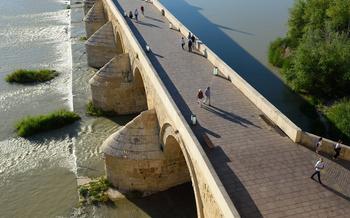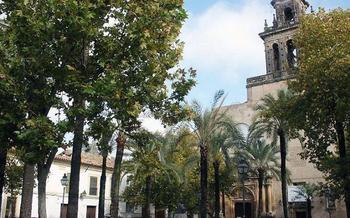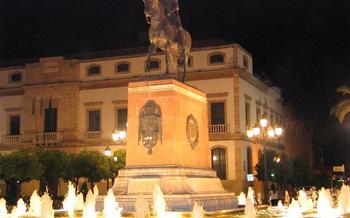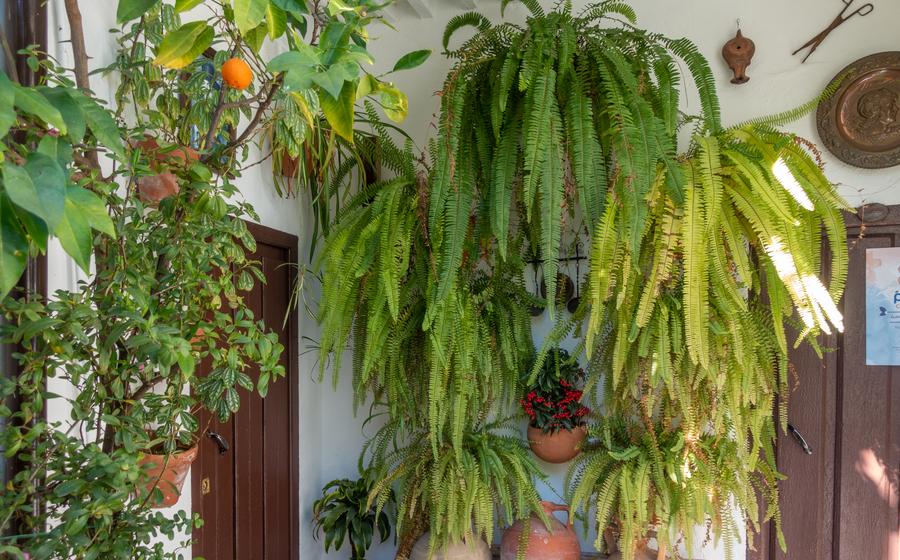
Patios de Córdoba
- A Patio Paradise
- A Stroll Through History
- Courtyards and More
- Insider Tips for Patio Viewing
- The Jewish Quarter
- The Alcázar de los Reyes Cristianos
- The Great Mosque of Córdoba
- The Roman Bridge
- The Alcázar Gardens: A Haven of Tranquility
- The Museo Arqueológico de Córdoba
- The Zoco Municipal
- The Museo Sefardí
- Insider Tip
A Patio Paradise
Córdoba, a city in southern Spain, is renowned for its stunning courtyards, known as patios. These hidden gems, tucked away behind unassuming doorways, are a testament to the city's rich history and vibrant culture. With their colorful flowers, intricate tilework, and tranquil fountains, the patios of Córdoba offer a unique and unforgettable experience for visitors.
The tradition of courtyards in Córdoba dates back to the Middle Ages, when the city was under Moorish rule. The Moors, known for their love of gardens and water features, introduced the concept of courtyards as a way to create a cool and inviting space within the confines of their homes. Over time, the patios evolved into a symbol of Córdoba's unique identity, blending Moorish, Jewish, and Christian influences.
In 1980, the courtyards of Córdoba were recognized for their cultural significance and were designated as a UNESCO World Heritage Site. This prestigious designation highlights the importance of these unique spaces and ensures their preservation for future generations.
Each year, Córdoba celebrates its rich patio tradition with the Patio Festival, held in May. During this festival, the city's courtyards are open to the public, allowing visitors to admire their beauty and experience the vibrant atmosphere of the city. The festival is a unique opportunity to immerse oneself in the culture of Córdoba and to appreciate the artistry and craftsmanship that goes into creating these stunning spaces.
The patios of Córdoba are a national tourist attraction, drawing visitors from all over Spain and the world. These hidden gems offer a glimpse into the city's rich history and vibrant culture, and are a must-see for anyone visiting Córdoba.
A Stroll Through History
Córdoba is a city steeped in history, and its streets are lined with architectural treasures that tell the story of its past. A stroll through the city center is a journey through time, taking you from the ancient Roman bridge to the medieval Jewish quarter, and from the Renaissance Alcázar to the stunning Great Mosque.
The Jewish Quarter, known as the Judería, is a living museum of Jewish history and culture. Here, you can visit the Synagogue, one of the best-preserved synagogues in Spain, and the Zoco Municipal, a vibrant market where you can find traditional crafts and souvenirs. The Museo Sefardí tells the story of the Jewish community in Córdoba, from its origins to its expulsion in 149
The Alcázar de los Reyes Cristianos, built by the Catholic monarchs after the Reconquista, is a stunning example of Renaissance architecture. The Alcázar is surrounded by beautiful gardens and offers stunning views of the city. The Torre del Homenaje, the tallest tower in the Alcázar, offers panoramic views of Córdoba and the surrounding countryside.
The Great Mosque of Córdoba, a masterpiece of Islamic architecture, is one of the most important monuments in Spain. Built in the 8th century, the mosque is a testament to the power and splendor of the Umayyad dynasty. The mosque's most striking feature is its Forest of Columns, a seemingly endless array of columns that support the roof. The Mihrab, the prayer niche, is a masterpiece of Islamic art, with its intricate carvings and colorful tiles.
Courtyards and More
In addition to the courtyards, Córdoba offers a wealth of other attractions. The Alcázar Gardens, located next to the Alcázar de los Reyes Cristianos, are a peaceful oasis with beautiful gardens, fountains, and sculptures. The Palacio de Viana, a stunning palace with 12 patios, is a must-see for any visitor to Córdoba. The Casa Andalusí, a traditional Andalusian house, offers a glimpse into the past with its beautiful courtyard and exhibits on Andalusian culture. The Museo Arqueológico de Córdoba is a journey through history, with exhibits on the city's past from prehistory to the present day.
Insider Tips for Patio Viewing
To make the most of your visit to the courtyards of Córdoba, here are a few insider tips:
Plan your visit during the Patio Festival: Held annually in May, the Patio Festival is the best time to experience the courtyards of Córdoba. During the festival, over 50 courtyards are open to the public, and there are special events and activities throughout the city.
Get a map of the courtyards from the tourist office: The tourist office provides a free map of the courtyards, which will help you plan your route and find the most beautiful patios.
Dress respectfully when visiting the courtyards: The courtyards are private property, so it is important to dress respectfully. Avoid wearing shorts, tank tops, or other revealing clothing.
Be prepared for crowds during the festival: The Patio Festival is a popular event, so be prepared for crowds. If you want to avoid the crowds, visit the courtyards early in the morning or late in the afternoon.
The Jewish Quarter
The Jewish Quarter, known as the Judería, is one of the most captivating and well-preserved Jewish quarters in the world, transporting visitors back in time to a vibrant and diverse community that once thrived here. Wander through the narrow, winding streets, lined with whitewashed houses adorned with intricate iron balconies, and discover a rich tapestry of history, culture, and tradition.
The Synagogue, a living testament to the city's past, stands as a symbol of the Jewish community's resilience and faith. Built in the 14th century, it is one of the few remaining synagogues from that era in Spain and offers a glimpse into the rituals and customs of the Jewish people.
Step into the Zoco Municipal, a vibrant market that buzzes with activity, where you can immerse yourself in the sights, sounds, and aromas of traditional Andalusian life. Browse through stalls brimming with colorful spices, fresh produce, and handmade crafts, and soak up the lively atmosphere as locals go about their daily lives.
The Museo Sefardí, housed in a former synagogue, takes you on a journey through the history of the Jewish community in Córdoba. Through interactive exhibits, artifacts, and multimedia presentations, you'll learn about their contributions to the city's cultural heritage and the challenges they faced during the Inquisition.
The Alcázar de los Reyes Cristianos
The Alcázar de los Reyes Cristianos is a must-see for any visitor to Córdoba. This stunning palace was built by the Catholic Monarchs after the Reconquista, and it served as their residence during their visits to the city.
History and Architecture
The Alcázar was built on the site of a former Moorish palace, and it incorporates many elements of Islamic architecture. The exterior of the palace is decorated with intricate carvings and tiles, and the interior features a series of grand halls and courtyards.
The Alcázar Gardens
The Alcázar Gardens are one of the most beautiful and peaceful spots in Córdoba. The gardens feature a variety of flowers, trees, and fountains, and they are a great place to relax and escape the hustle and bustle of the city.
The Torre del Homenaje
The Torre del Homenaje is the tallest tower in the Alcázar, and it offers stunning views of the city and the surrounding countryside. The tower is open to the public, and it is a great place to take in the sights of Córdoba.
The Royal Stables
The Royal Stables are home to a collection of horses that were once used by the Catholic Monarchs. The stables are open to the public, and visitors can learn about the history of the horses and the role they played in the Reconquista.
The Great Mosque of Córdoba
The Great Mosque of Córdoba, also known as the Mezquita-Catedral de Córdoba, is one of the most iconic landmarks of the city and a masterpiece of Islamic architecture. Originally built as a mosque in the 8th century, it was later converted into a cathedral after the Christian Reconquista in the 13th century, resulting in a unique blend of Islamic and Christian elements.
History and Architecture The Great Mosque was built by the Umayyad dynasty, the first Muslim dynasty to rule Spain, and was expanded over the centuries by subsequent Muslim rulers. The mosque's design is characterized by its iconic rows of arches and columns, which create a sense of grandeur and spaciousness. The mihrab, or prayer niche, is one of the most impressive features of the mosque, with its intricate tile work and gold leaf decoration.
The Mihrab Located at the qibla wall, the mihrab is the most sacred part of the mosque and indicates the direction of Mecca. It is a masterpiece of Islamic art, featuring a stunning combination of marble, tile work, and gold leaf decoration. The mihrab is surrounded by a series of horseshoe arches, which create a sense of depth and perspective.
The Forest of Columns The interior of the Great Mosque is supported by a forest of over 800 columns, which create a sense of awe and wonder. The columns are made of a variety of materials, including marble, granite, and jasper, and are topped by a variety of capitals, each with its own unique design. The columns are arranged in rows, which create a series of aisles that lead to the mihrab.
The Qibla Wall The qibla wall is the wall that faces Mecca, the direction towards which Muslims pray. In the Great Mosque, the qibla wall is located on the southern side of the building. It is decorated with a series of arches and niches, which create a sense of depth and perspective. The qibla wall is also home to the mihrab, the most sacred part of the mosque.
The Roman Bridge
The Roman Bridge, also known as Puente Romano, is one of the most emblematic landmarks of Córdoba. Built in the 1st century BC, it is a testament to the city's ancient past. The bridge spans the Guadalquivir River and connects the historic center of Córdoba with the Campo de la Verdad neighborhood.
The Roman Bridge is constructed from large blocks of stone and features 16 arches, each of which is decorated with a unique design. The bridge is also adorned with statues of various saints and mythical figures. The most famous statue is that of San Rafael, the patron saint of Córdoba, who is depicted holding a fish and a staff.
The Roman Bridge is a popular tourist destination and offers stunning views of the city. It is also a popular spot for taking photos and enjoying a leisurely stroll. The bridge is especially beautiful at night when it is illuminated by floodlights.
Legend of the bridge:
There is a legend associated with the Roman Bridge that tells the tale of a young woman named La Cava who was in love with a Christian knight named Rodrigo. La Cava's father, Count Julian, was the governor of Ceuta and was opposed to their relationship. In a fit of rage, Count Julian betrayed the city to the Moors, who invaded and conquered Córdoba. Rodrigo was killed in the battle, and La Cava was taken prisoner. She was later rescued by her brother, but she died of a broken heart.
The legend of La Cava is a tragic tale of love and betrayal, and it is a reminder of the city's rich and complex history.
The Alcázar Gardens: A Haven of Tranquility
In the heart of the Alcázar de los Reyes Cristianos, a magnificent palace that once housed the Catholic monarchs of Spain, lies a hidden gem: the Alcázar Gardens. Designed in the Renaissance style, these lush gardens offer a tranquil oasis amidst the bustling city.
Fragrant Oasis: The gardens are a riot of colors and fragrances, with vibrant flowers blooming in every corner. The Orange Tree Courtyard, a particular highlight, features rows of fragrant orange trees that fill the air with a sweet scent. Take a stroll along the Cypress Tree Avenue, a shady promenade lined with towering cypress trees that create a serene atmosphere.
Stunning Centerpiece: At the heart of the gardens lies the Fountain of the Lions, a stunning masterpiece that captures the essence of the Renaissance era. The fountain, adorned with intricate carvings of lions and other mythical creatures, cascades into a pool of crystal-clear water, creating a mesmerizing spectacle.
Tranquil Escape: Whether you're seeking a peaceful retreat from the city's hustle and bustle or simply want to admire the beauty of nature, the Alcázar Gardens offer a sanctuary of serenity. Take a moment to relax on one of the many benches scattered throughout the gardens and let the soothing sounds of water and birdsong wash away your worries.
The Museo Arqueológico de Córdoba
The Museo Arqueológico de Córdoba prehistoric origins to its role as a Roman city and the capital of the Umayyad Caliphate. The museum's collection includes artifacts from all periods of Córdoba's history, including Roman mosaics, Visigothic jewelry, and Islamic pottery.
The museum is housed in a former convent, and its exhibits are arranged chronologically, making it easy to follow the development of Córdoba's culture and society over time. The museum's highlights include the collection of Roman mosaics, which are some of the finest examples of Roman art in Spain. The museum also has a collection of Visigothic jewelry, which is evidence of the city's importance as a center of Visigothic power.
The Museo Arqueológico de Córdoba is a valuable resource for anyone interested in the history of this fascinating city. Its collections are extensive and well-presented, and the museum's staff is knowledgeable and helpful.
The Zoco Municipal
The Zoco Municipal is a vibrant market located in the historic Jewish Quarter of Córdoba. It is a bustling hub of activity, where locals and tourists alike come to browse the stalls and soak up the atmosphere. The market has been in operation since the 13th century, and it is one of the oldest and most traditional markets in the city.
The Zoco Municipal is a great place to find souvenirs and gifts, as well as fresh produce, spices, and other local delicacies. The stalls are packed with colorful textiles, ceramics, leather goods, and jewelry. There are also a number of bars and restaurants in the market, where you can stop for a bite to eat or a refreshing drink.
The atmosphere in the Zoco Municipal is electric, with the sound of haggling, the smell of spices, and the laughter of shoppers filling the air. It is a great place to experience the sights, sounds, and smells of traditional Andalusian life.
If you are looking for a unique and authentic experience in Córdoba, be sure to visit the Zoco Municipal. It is a fascinating glimpse into the city's past and a great place to find souvenirs and gifts to take home.
The Museo Sefardí
The Museo Sefardí is a must-see for anyone interested in the history and culture of the Jewish community in Córdoba. The museum is housed in a 14th-century synagogue, which is one of the few remaining synagogues in Spain. The exhibits tell the story of the Jewish community in Córdoba, from its origins in the Roman period to its expulsion in 149The museum also has a collection of artifacts from the Jewish past, including religious objects, manuscripts, and textiles.
The Museo Sefardí is a fascinating and informative museum that provides a glimpse into the rich history of the Jewish community in Córdoba. The exhibits are well-curated and the staff is knowledgeable and friendly. If you are interested in learning more about the Jewish history of Córdoba, the Museo Sefardí is a must-visit.
Insider Tip
- Visit the courtyards early in the morning or late in the afternoon to avoid the crowds. This is especially important during the Patio Festival when the courtyards are packed with visitors.
- Take your time and savor the beauty of each courtyard. Don't just rush through them, but take a few minutes to appreciate the details of each one.
- Don't forget your camera to capture the stunning sights. The courtyards of Córdoba are a photographer's paradise, so make sure you have your camera ready to capture the beautiful flowers, fountains, and architecture.

